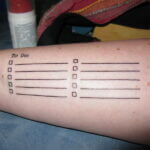The 25 Best Ways To Boost Creativity

Our phones do so much for us, and modern conveniences have dulled the need for grit in everyday life. Since grit is often what makes us creative, it can be a challenge to engage the creative side of your brain.
Thankfully, we’re here to help with some suggestions for how you can boost creativity immediately. You will find such lists online with more entries than this one, but that was not the point of our efforts.
We’ve culled through hundreds of suggestions to bring you only the best. And if this isn’t enough, well, there may be a few surprises waiting for you at the end. Let’s get started!
Boost Creativity Tip No. 1. Turn yourself into an idea generating machine.
Sometimes the easiest way to boost creativity is to simply go into “robot” mode. Turn your ideas on like they’re a machine and just let them flow.
Good, bad, ugly, crazy. Let stuff fall out of your head no matter how far fetched or certifiable. In doing so, you will find a lot of crap, but you will also find a few pearls that allow you to hone in on a valuable approach that can then command the lion’s share of your critical creative thinking.
If you’re having trouble coming up with five ideas, force yourself to come up with 10. If 10 is the trouble, make it 20. By forcing your brain beyond its limits, you give it permission to try anything, and you end up breaking through those more limiting barriers.
2. Combine ideas and make associations.
One of the techniques that will make you a terrific reader also applies to creative thinking — connections. By making text-to-text, text-to-world, and text-to-self comparisons as you’re reading, you’re able to better grasp complex material.
In the same way, taking one thing and combining it with another or making associations of any kind between two or more ideas will open a floodgate of creative thinking.
3. Learn to focus and turn off ‘noise.’
While volume of ideas will often lead to more creativity, the opposite is also true. Focusing on one thing will free you up to think about it in different ways.
Soon your creative mind is generating tons of new ideas for how to approach a singular problem. You’ve just got to learn to turn off distractions and outside “noise,” be they people, technologies, or a combination of the two.
4. Keep creative company.
When athletes are trying to improve their performance, they prefer to train or compete against other athletes who are at the same level or higher. While “winning” is great, it isn’t going to help them elevate performance if they’re getting the better of a mismatch.
In similar fashion, keeping company with other creative people will allow you to sharpen the mind muscles responsible for creative thought. It has been said you are the average of the five people with whom you spend the most time.
Make sure those five people aren’t knuckleheads, or there is a good risk of you joining them.
5. Freewrite.
Getting into the “flow” of something is a tremendous way to boost creativity, and while there are numerous methods available for doing this, one of the best is the freewrite method.
Just you, a sheet of paper, and a timer, or trade paper for a time-centric word processing program like FlowState, and you’re off to the races.
By freewriting, you’re giving yourself permission to jot down anything that comes out of your head even if you end up throwing away most of it or have trouble getting started and have to force out meaningless drivel.
Stay disciplined to the freewrite, and the good stuff will come.
6. Embrace ritual.
Ritual can seem rather limiting and boring, but once you commit to it, you will realize just how liberating and productive it makes you.
The important thing about ritual is that you do your best not to deviate from it. That means choosing the appropriate time of day for when you do your best work.
Most people, as they get older, value their mornings because this is the portion of the day where work, school, family, and other distractions aren’t getting in the way.
Your ritual time doesn’t have to be in the A.M., but it does need to be at a time when you have the most time to yourself thought-wise.
7. Be open to new things.
Do you know of someone, who has grown into old age and now seems, not to be mean, dumber or less aware of the world around them?
It may not be dementia at play. It could simply be that person has made up their mind about how they see the world, and they’re no longer accepting new ideas.
When you close yourself off to other viewpoints — note: you can still disagree with other viewpoints while being open to hearing them — you shut down an important part of your brain that strips away creative thinking.
Always be the type of person willing to expand your horizons, and you’ll always be the type of person capable of creativity.
8. Coffee up!
Coffee has achieved a sort of mystical quality among creative types because the caffeine gives an energy boost, often at a time of day when needed the most.
Many see this beverage as fuel that gets the body engine going, but it’s a lubricant that applies to the mind as well.
When you feel more alert, you will be more open to new ideas as well as capable of finding new ways to tackle old problems.
So get that pot percolating or swing into the nearest Starbucks ASAP.
9. Turn off technology.
Technology can augment the creative mind, but it can also shut it down completely. Finding the balance is tricky business because of the rabbit hole effect our devices produce.
When you really have to get creative thinking done, send your phone into “Do Not Disturb” mode for a preset length of time that allows your brain to do what it does. The emails and texts aren’t going anywhere, and how much do you really need to see of social media before realizing that time’s a-wasting?
10. Schedule time to be creative.
A schedule will help you stay on track with lots of tasks and objectives. Creativity is no different. When you carve out time for being creative, your brain will take over and know what to do for the time you’ve given it.
And since creativity is like a muscle — if you don’t use it, you lose it — you’ll find it easier and easier the more sessions you successfully complete.
But a word of warning: if you relegate creativity to an afterthought, you’ll never take it seriously enough to find the time for it.
11. Go for a walk. A long walk!
Ever wonder why your brain feels fried after a long study session? It’s because you have been sitting in one place too long, and you have become too ensconced in the material to think about it with a fresh perspective.
By getting away from your desk for a while and going for a walk, you give your thoughts a chance to wander and reenergize for the next task. While some will tell you to schedule five or 10-minute breaks and walk the whole time, we’re not big believers in screwing up flow.
So don’t be so regimented. Simply come to a stopping point or go until you feel yourself becoming ineffective, and then walk until you have the tolerance for your to-do list once again.
12. Exercise.
Going for the intermittent walk is important, but it is not going to keep your body in tip-top shape over time. For that, you will need to incorporate more strenuous exercise more frequently.
This has a direct effect on your creative brain as well because a healthy body means a healthy mind. You can also take advantage of the time away from books and computers to take in the world around you and wrestle with challenging problems as you put your body through the wringer.
It is important to note that you do not have to be an athlete or train like one. You just have to push your body beyond what it is used to, and you have to do it regularly in order to derive the best effects.
13. Spend time with kids — seriously.
Kids may seem like annoying little booger machines to you if you aren’t the parent of one — and heck, those of us who are parents feel that way, too, from time to time — but what they often lack in manners and behavior, they make up for with imagination.
You don’t want to think like a kid all the time, especially as you get older, because what a selfish world that would be! But you do want to examine how these little people with their big thoughts see the world.
When you spend time with a child of average or higher development, you gain a whole new perspective for the way the world is and what is possible.
14. Read!
Reading is another one of the best ways to boost creativity because you get to take a private tour through the thoughts and the research of others.
These are people who have (usually) thoroughly examined what they are going to say and then formulated said thoughts and data into a cohesive narrative. This cannot be dismissed when it comes to how it affects your ability to think creatively.
Challenge yourself with reading. If you’re a fiction reader, find time to catch up on your author list, but also make room for nonfiction. Vice versa if you prefer nonfiction.
Reading is also a great way to become a lifelong learner, which will make you a person who thrives on creativity rather than one who simply has to find sporadic chunks of time for it.
15. Thought experiment: get fired (not literally).
This was a rather fun idea that we admittedly stole from someone else — no worries, they’re one of the surprises we link to at the end of this piece. Anyhow, think about your job. What is something you could envision yourself doing to get fired?
For some of you, the task itself will be an easy one — almost too easy — but take the time to think of the most outlandish ways you could pull it off.
Now once you’ve decided, make sure you don’t actually DO any of it. Just think it. It will engage your creative brain and lead to viewing issues from more than one angle, which is a hallmark of creative thinking.
16. Draw. Yes, even if you’re terrible at it.
Drawing art, even if you stink at it, is a great way to be creative because it forces you to visualize something. Those visualization techniques can then be ported over to a problem or project and put to good use.
Start with a clean sheet of paper or a favorite art app and draw an object in the room where you’re now sitting (if you have trouble coming up with ideas).
17. TOC your problem.
By TOC, we mean “Table of Contents.” But wait!, you may be thinking: that’s not a verb! No, it isn’t. Rather it’s the section of a book that will tell you exactly what you’re about to learn in a piece-by-piece manner.
By taking a problem or issue you’re currently working on and creating a TOC for an imaginary book that you are writing on the topic, you can engage creativity in a way that turns abstract concepts and ideas into concrete, actionable steps.
18. Daydream.
Not to go into broken record mode, but we fear the art of daydreaming is a vanishing one due to the rise of the smartphone.
When a class used to bore us to tears, we crawled inside our brains and allowed a made-up movie of our lives to play out in contained unseen images within the walls of our skulls.
Nowadays, we just look down and pull up Twitter or Instagram. Try to buck the trend, and instead, when you feel yourself zoning out, allow your mind to go without being tethered to a phone. (Preferably outside of class so your teacher doesn’t know.)
19. Imagine you’re somebody else — someone you know for the best effects.
You can spend so much time with yourself that it starts to show in how you approach problems. If you are boring and predictable to you, then you aren’t going to approach problems in a way that is particularly innovative and inspirational.
When this happens, try stepping outside of yourself and asking the question, how would someone else handle this?
Now, we’re fully aware that can be difficult if you don’t fashion yourself instinctively creative, so when doing so, create an alternate persona by going to the people in your life.
Try to envision how your mom or dad or favorite teacher or least favorite teacher or priest or rabbi or significant other might approach the issue. Write down possible approaches for each. By “seeing” through a foreign yet familiar set of “eyes,” your brain will go well beyond its capacity for creativeness.
20. Approach a problem from multiple POVs.
A bit of an extension from No. 19, but different enough to enjoy its own part. When you approach a problem from multiple points of view, you see how something might “play out” depending on which specific action you take.
As you’re doing this exercise, you might be able to find new solutions by combining points of view, or simply walking through the process might turn you onto a solution you haven’t thought of yet.
21. Examine your failures or something unexpected that you learned.
When you fail at something, it’s easy to look back and find the misstep. After all, you’re living with the outcome of that misstep in the present!
On the flip side of that, maybe something turned out better than expected. Why?
This analysis will allow you to strengthen your creative muscles for current and future endeavors, though it can be admittedly hard reliving a failure.
22. Two words — classical music!
Classical music like that of Mozart or Beethoven has been linked to instances of boosted creativity. There is a reason everyone tells you to listen to such tunes while studying.
Amazon Prime Music even has remade playlists that you can get called “Classical for Reading,” “Classical for Focus,” and “Classical for Studying.”
You won’t find lyrics in any of them because when people sing lyrics, your brain tends to connect with the human experience they are singing about regardless of how shallow and repetitive.
By keeping things instrumental, you ensure that the brain stays rooted on the issue and that the music stays in the background where it belongs.
23. Give up.
Some say to “Never give up” as if that’s good advice. Truthfully, it can be the worst advice if what you’re doing isn’t working. Rather than blindly obey like a zombie, you should be willing to embrace giving up when it makes sense.
Because in giving up an approach, you’re not necessarily moving closer to failure. You might instead be re-strategizing and finding a better way to accomplish your goal.
Remember: it’s not allowing yourself to fail that makes you a failure. It’s the next moves you make after it that will ultimately determine.
24. Meditate.
Meditation can take many forms. Some leave it at that. Religious people often find it synonymous with prayer. The goal is to tap into the bigger universe and focus on finding meaning.
By going to a quiet place, adopting a healthy posture, and allowing your thoughts to be free in silence for a bit, you can delve into a deeper state of understanding. This state will prepare every part of your brain, including the creative side.
25. Write by hand.
Writing tasks out by hand is a great way to goose your creativity. The blank page has a power to it that invites one to fill it up with as much stuff as possible.
Transmitting that “stuff” from brain to page with your hand as the steady guide will allow you to more carefully formulate ideas.
So there you have it, good reader. We thank you for hanging with us this long, and also want to invite you to check out these other sites for more actionable advice on how you can boost creativity in your work and student life. What techniques have really helped you excel in this regard? Please share in the comments section below!
[Featured Image by Flickr Creative Commons]








